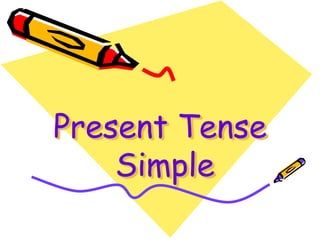
PRESENT SIMPLE TENSE..ppt
- 2. Definition • The present tense simple in English is used to describe an action that is regular, true or normal.
- 3. When we use present tense simple? 1. For repeated or regular actions in the present time period. • I take the train to the office. • The train to Berlin leaves every hour. • John sleeps eight hours every night during the week. 2. For facts. • The President of The USA lives in The White House. • A dog has four legs. • We come from Switzerland.
- 4. 3. For habits. • I get up early every day. • Carol brushes her teeth twice a day. • They travel to their country house every weekend. 4. For things that are always / generally true. • It rains a lot in winter. • The Queen of England lives in Buckingham Palace. • They speak English at work.
- 5. Verb Conjugation & Spelling • We form the present tense using the base form of the infinitive (without the TO). • In general, in the third person we add 'S' in the third person. • Example: He / She / It speaks English at home.
- 6. • The spelling for the verb in the third person differs depending on the ending of that verb: 1. For verbs that end in -O, -CH, -SH, -SS, - X, or -Z we add -ES in the third person. • go – goes • catch – catches • wash – washes • kiss – kisses • fix – fixes • buzz – buzzes
- 7. 2. For verbs that end in a consonant + Y, we remove the Y and add -IES. • marry – marries • study – studies • carry – carries • worry – worries • 3. For verbs that end in a vowel + Y, we just add -S. • play – plays • enjoy – enjoys • say – says
- 8. Negative Sentences in the Present Tense Simple • To make a negative sentence in English we normally use Don't or Doesn't with all verbs EXCEPT To Be and Modal verbs (can, might, should etc.). • We add don't between the subject and the verb. We use Don't when the subject is I, you, we or they. • Example: is I/ you/ we/ they don't speak French.
- 9. • When the subject is he, she or it, we add doesn't between the subject and the verb to make a negative sentence. • Example: he/ she/ it doesn't speak German. • The following is the word order to construct a basic negative sentence in English in the Present Tense using Don't or Doesn't : • Subject + don't/doesn't + Verb + The Rest of the sentence. • Example: I don’t like cats.
- 10. Questions in the Present Tense Simple • To make a question in English we normally use Do or Does. It is normally put at the beginning of the question. • We add DO at the beginning of the affirmative sentence to make it a question. We use Do when the subject is I, You, we or they. • Example: Do I/ you/ we/ they speak English?
- 11. • When the subject is he, she or it, we add DOES at the beginning to make the affirmative sentence a question. • Example: Does he/ she/ it speak French? • We DON'T use Do or Does in questions that have the verb To Be or Modal Verbs (can, must, might, should etc.) • The following is the word order to construct a basic question in English using Do or Does: • Do/Does + Subject + Verb + The Rest of the sentence. • Example: Do you like cats?